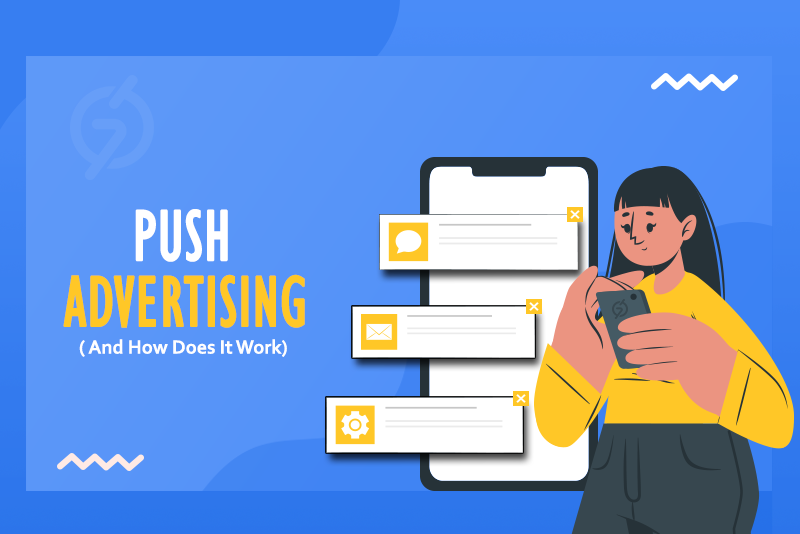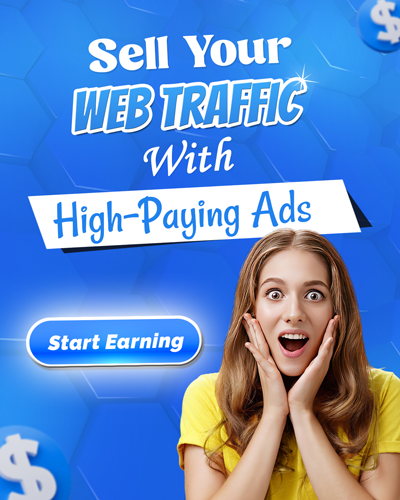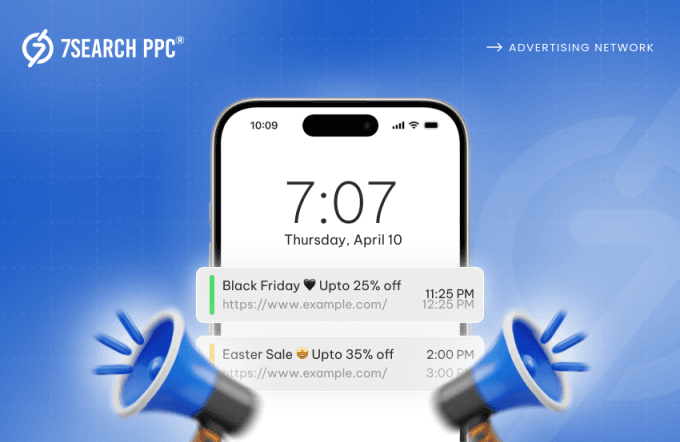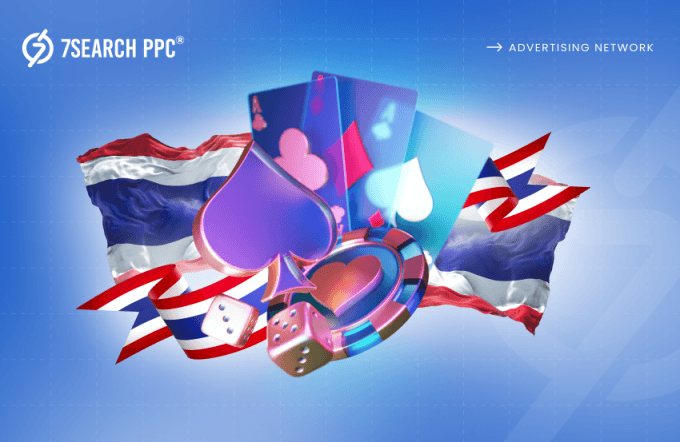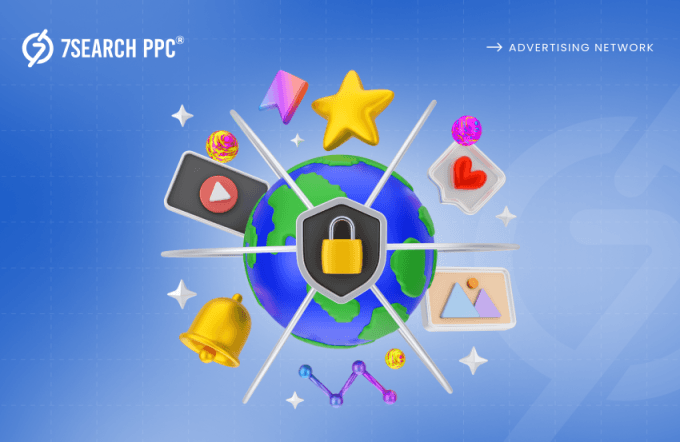Are you looking for quality traffic but unable to find the perfect source to obtain it? Yes, that’s a big problem that most advertisers face in the world of digital advertising. Traffic is like oxygen for advertisers, as they need it to survive in the competitive online marketplace. But before we jump directly on the high-traffic source, tell us something.
Do you remember that exciting ping on your phone that is a sale alert?
That’s push advertising for you, which is the source you have been looking for for a long time.
For the past ten years, push notifications have quietly become an advertiser’s best friend. Why? Because people actually notice them. Push ads boast a remarkable 90% open rate. Did you know that push ads have shown over 50% growth compared to email marketing? Yes, they can reach 50% more people effectively.
The best thing is that they work perfectly on desktops and laptops, not just phones. Basically, it is like having a shortcut route that can help you easily reach your audience—perfect for sending quick updates, special offers, or reminding the existence of your brand.
Are you curious to learn more about the push ad format? Keep reading this blog and find out how push ads can be the key to reaching more people and enhancing your advertising efforts.
What Exactly is Push Advertising?
When we apply force to something to make it move forward, such as pushing a square box or opening a door, this action is generally referred to as a “Push“. Now, you must be thinking that we are discussing a digital advertising topic, but the content actually pertains to science. My friend, this science is applied in advertising, which makes the term “Push Advertising“. How? Let’s find out.
Push advertising involves sending promotional messages directly to users’ devices as push notifications. These messages briefly appear on smartphones or computers, often with icons and action buttons. Unlike traditional ads, push ads take advantage of the immediacy of notifications to instantly engage users. They can promote special offers, provide updates, or encourage completing a purchase.
This ad format is preferred for its non-intrusive nature, similar to native ads, as it seamlessly blends with user experiences. While push notifications and push advertising use the same delivery methods, the latter specifically focuses on delivering marketing content rather than system updates or app features.
How Push Advertising Works
Ting tong! A doorbell rings. You check that your lovely neighbor is standing outside with a basket of freshly baked cookies. You open a door because you know that your neighbor is not annoying and his intention is to distribute cookies for promotion. That’s how push advertising works!
It uses push notifications to deliver targeted messages directly to a user’s device, whether it’s a phone or computer. However, unlike some online ads, push notifications require the user’s permission first.
Here is how it works:
- Opt-in: The website or app will ask the user for permission to send notifications. This can be a straightforward question like “Allow notifications?” or it might be phrased to highlight the benefits, like “Click here for exclusive deals!”
- Consent Granted: Once a user agrees (opts-in), the advertiser can then send push notifications containing brief messages, images, and even buttons that prompt an action.
- Targeted Messages: Because users have opted in, advertisers can assume a certain level of interest. This allows for more targeted messaging that’s likely to resonate with the user and potentially lead to a sale or other desired action.This opt-in process is crucial, which makes push advertising different from other forms of advertising. It ensures that users are willing to receive notifications, making it a powerful tool for businesses to engage with their audience.
The Advantages of Push Advertising
Average US smartphone users receive 46 app push notifications per day. The over all push notification opt-in rate is 60%. Europe leads with the highest response rates to push notifications on Android (11.4%) and iOS (5.5%). This data suggests it is beneficial for advertisers who are looking to buy push traffic through push advertising.
Here are some benefits you will gain from using it for your ad campaigns!
Immediate Reach
Don’t worry about overflowing email inboxes or busy social media feeds. Push notifications land directly on a user’s device, bypassing information overload. This significantly boosts the chances of your ad being seen. The key is to make sure your push notifications are relevant and timely.
For example, if you have a travel app, a generic notification might be ignored. However, a notification targeting users who recently looked at vacation rentals in a particular location during a sale is likely to catch their attention.
High Engagement Rates
Push notifications have a much higher click-through rate (CTR) in contrast to traditional display ads, meaning a larger percentage of users who see your push notification will actually click on it. There are two main reasons for this. First, users who opt-in for push notifications have already shown some interest in your brand. Second, push notifications appear on a user’s device, demanding immediate action, unlike an ad passively viewed on a website.
Improved User Attention
Push notifications are a valuable tool for re-engaging existing users with your app or website. For instance, if a user adds items to their cart but leaves without making a purchase, a well-timed push notification reminding them about the abandoned items can encourage them to complete the purchase. Additionally, these notifications can be used to:
- Announce new features
- Offer exclusive discounts
- Remind users about upcoming events
- This not only boosts sales but also helps in building customer loyalty and sales.
Targeted Reach
Push advertising offers a high level of targeting that traditional advertising often can not achieve. You can segment your audience based on:
- Demographics (Age, Location)
- Interests (Travel, Sports)
- Past Behaviour (Abandoned Carts, Viewed Products)
- This precise targeting guarantees that your messages reach the users most likely to be interested in what you have to offer,
- thus maximizing the effectiveness of your advertising campaign.
Budget-Friendly Advertising
Push advertising is a cost-effective marketing strategy when compared to other options. The cost is often based on a pay-per-click (PPC) model, so you only pay when your audience/user clicks on your push notification and lands on your app or website. There are no upfront costs, and you only spend money when your campaign generates interest.
This makes push advertising a good choice for businesses of all sizes, particularly those aiming to maximize their return on investment (ROI).
Web Push vs. App Push: Know the Difference
Web push notifications and app push notifications differ primarily in their delivery method and target devices. We have differentiated both under the following categories:
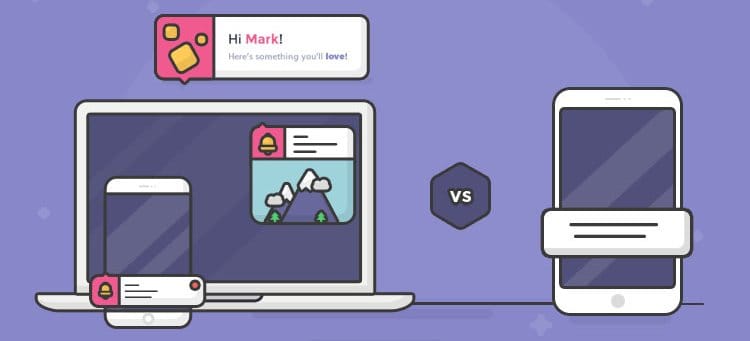
Origin and Delivery
- App Push Notifications: These notifications originate from a mobile app installed on the user’s device and are delivered through the app itself. They can be sent at any time, but the recipient must have the app installed to receive them.
- Web Push Notifications: They are also known as in-page push notifications. These are delivered via a web browser to both mobile phones and desktop computers. They can appear similar to app push notifications on mobile devices but are sent from a website rather than the app.
Visibility and Reach
- App Push Notifications: These push notifications usually appear on a user’s mobile screen, even if the app is not actively open. They are prominent and can immediately grab attention.
- Web Push Notification: On desktops, these notifications appear in the corners of the screen when the browser is open. On mobile devices, they can be received regardless of whether the browser is actively in use, making them versatile for reaching users in various contexts.
Accessibility
- App Push Notifications: These push notifications are limited to users who have installed the specific mobile app. They are delivered using code integrated within the app, ensuring that only users who have downloaded the app can receive them on their devices.
- Web Push Notifications: A website with an enabled web-push code is accessible to any visitor with a supported browser. This wider accessibility is beneficial for marketers who may not have an app but still want to engage users with push notifications.
How Push Advertising Can Transform and Boost Sales for Your Business
Push notification is a crucial part of omnichannel campaigns. It not only shows ads but also offers new opportunities to promote your content and meet all your business goals. It does more than just display ads; it opens up new ways to promote your content and achieve various business goals.
Here is how push advertising can transform and boost sales for your business.
Sales and User Engagement
- Increased Clicks and Conversions: Push notifications are designed to grab user attention and drive action. They can effectively promote special offers, discounts, and new product launches, leading to more clicks, views, and, ultimately, sales.
- Enhanced Brand Awareness: Regular and specific notifications can help keep your brand at the forefront of your customers’ thoughts.
- Deeper User Engagement: Push notifications offer a direct line of communication with your audience. You can use them for surveys, feedback requests, or even educational content to build trust and loyalty.
Versatility in Reaching Your Audience
Push notifications offer a wide range of content options to keep your audience engaged:
- Promotional Offers: Announce discounts, sales, and other limited-time deals.
- Content Updates: Inform users about new blog posts, product updates, or downloadable content like ebooks.
- App Promotion: Encourage users to download your app with special incentives.
- Personalized Reminders: Trigger location-based alerts for seasonal discounts or nearby promotions.
- Interactive Elements: Use surveys and questionnaires to gather valuable user feedback and improve your brand.
The Power of Personalization
Push advertising approaches are highly customizable. They allow you to tailor messages to specific user segments. This personalization approach builds a stronger bond with your audience and makes your promotions more relevant. Overall, it leads to a higher chance of conversion.
Overall Impact
By using push advertising in your marketing strategy, you can make your campaigns more diverse and effective. Push notifications allow you to connect more deeply with your audience, leading to high sales and engagement.
Top Verticals and Offers For Push Advertising
Push advertising can be highly effective in various industries. These industries use push notifications to capture the attention of their ideal audience and drive push traffic to their website.
Some of the verticals that fit for push advertising are given below:
E-commerce
Push advertising is widely used in e-commerce to announce sales, discounts, new products, and personalized offers based on user behavior.
- E-commerce brands send about 22% of all push notifications across different industries.
- The majority of e-commerce brands, over 90%, use push notifications to announce special offers and discounts.
iGaming (Online Casinos and Sports Betting)
The industry utilizes push notifications to alert users about upcoming games, sports events, and special betting opportunities.
- Roughly 26% of the world’s population participates in online gambling.
- In the United States, 46% of adults are interested in sports betting.
These data are enough to show that you can also use push notifications in your iGaming advertising strategy to engage a larger portion of the global and U.S. adult populations interested in online gambling and sports betting.
Travel and Tourism
Push advertising in travel and tourism encourages users to plan a trip by highlighting beautiful destinations, offering booking discounts, and reminding them about holiday seasons or special travel deals.
- The travel and tourism market is expected to see a significant increase in revenue globally in the upcoming years.
- By 2024, revenue is estimated to reach US$927.30 billion and is projected to grow annually at a rate of 3.47%, resulting in a market volume of US$1,063.00 billion by 2028.
Conclusion
Push advertising offers powerful tools for marketers to directly reach their target audience. With high open rates, strong engagement, and permission-based marketing, push notifications can significantly boost brand awareness, customer loyalty, and sales.
Whether you choose web push or app push notifications, this advertising strategy delivers measurable results with budget-friendly costs. By dividing your audience into groups and creating messages tailored to them, you can ensure that your push notifications resonate with users and motivate them to take action and complete desired tasks. Readers, apply the push advertising strategy to drive push ads traffic to your website/app now!
Frequently Asked Questions (FAQs)
What is push advertising?
Ans. Sending promotional messages directly to users’ devices as notifications is known as push notification marketing. These messages appear on phones or computers, often with icons and buttons.
Which platform is best for push ads?
Ans. 7Search PPC is best push ads platform, offers push notifications alongside other ad formats with competitive pricing.
How does push advertising work?
Ans. Similar to a doorbell ring, push notifications deliver targeted messages to a user’s device after they give permission. Users opt-in to receive notifications, allowing for more relevant messages.
How do web push notifications differ from app push notifications?
Ans. App push comes from an installed app, while web push comes from a website you visit. Web push works on both mobile and desktop, while app push mainly works on mobile phones.
Can push notifications be targeted?
Ans. Yes, push notifications can be targeted based on demographics, interests, and past behavior to reach the most interested users.
Are push notifications effective?
Ans. Push notifications have high click-through rates compared to other ads because users have already shown some interest.

